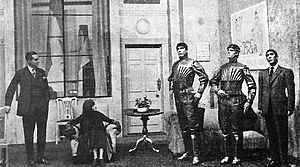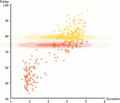Artificial intelligence facts for kids

Artificial intelligence (AI) is when a computer program or a machine can think and learn. It's also a field of study that tries to make computers "smart." John McCarthy first used the name "artificial intelligence" in 1955.
When people talk about AI, they usually mean a machine that acts like a human mind. Computers can do some things we link with thinking, like learning and problem solving. But they don't do it exactly the same way humans do.
An ideal smart machine can understand its surroundings. Then it takes actions to reach a goal. As machines get better, some abilities once thought to need intelligence are no longer called "AI." For example, reading text from images (like optical character recognition) is now just a normal technology.
Today, we use AI for many things. This includes understanding human speech and playing complex games. AI also helps with self-driving cars and understanding lots of data. Some people worry that AI could become a danger to humanity if it gets too advanced.
A big goal of AI research is to create programs that can learn, solve problems, and think logically. But in reality, most AI programs focus on tasks computers are good at. Computers are much better than people at searching databases and doing calculations. However, truly "understanding its environment" is still very hard for computers.
AI combines many different subjects. These include computer science, mathematics, linguistics, psychology, neuroscience, and philosophy. Researchers hope to create a "general artificial intelligence" one day. This kind of AI could solve many different problems, not just one. They also want to make AI that can be creative or show emotions.
Contents
How AI Began and Grew
Objects that look and act like humans appear in stories from many old civilizations. The idea of artificial intelligence first shows up in Greek myths. Examples include Talos of Crete or the bronze robot of Hephaestus. Human-like robots were also built by people like Yan Shi and Al-Jazari.
In 1920, Karel Čapek wrote a play called R.U.R.. This play introduced the word "robot." It comes from the Czech word "robota," meaning "forced labor." Čapek's book and Mary Shelley's Frankenstein made the idea of thinking machines popular in stories.
The study of formal logic helped create the idea of a computer. This study started with ancient Greek thinkers. In the 19th and 20th centuries, mathematician Alan Turing showed that computers could solve any math problem by processing 1s and 0s. New ideas in neurology, information theory, and cybernetics made some researchers believe an electronic brain was possible.
Real AI research began at a meeting at Dartmouth College in 1956. It was a month-long brainstorming session. Many people interested in AI attended. At this meeting, they created programs that were amazing for their time. These programs could beat people at checkers or solve word problems. The Department of Defense started giving a lot of money to AI research. Labs were created around the world.
But researchers had really underestimated how hard some problems were. The tools they had didn't give computers things like emotions or common sense. A mathematician named James Lighthill wrote a report about AI. He said that discoveries hadn't made the big impact that was promised. The U.S. and British governments wanted to fund more successful projects. So, money for AI research was cut. This started an "AI winter," where little research was done.
AI research came back in the 1980s. This was because of expert systems, which copied the knowledge of human experts. By 1985, one billion dollars were spent on AI. Newer, faster computers convinced the U.S. and British governments to fund AI again. However, the market for Lisp machines crashed in 1987. Funding was pulled again, starting an even longer AI winter.
AI became popular again in the 1990s and early 2000s. It was used in data mining and medical diagnosis. This was possible because computers were faster. Also, researchers focused on solving more specific problems. In 1997, Deep Blue was the first computer program to beat chess world champion Garry Kasparov.
Faster computers, new methods like deep learning, and access to more data have made AI popular worldwide. In 2011, IBM Watson beat the top two Jeopardy! players, Brad Rutter and Ken Jennings. In 2016, Google's AlphaGo beat top Go player Lee Sedol four out of five times.
AI in Government
In March 2023, the Prime Minister of Romania, Nicolae Ciucă, introduced an AI "honorary advisor" named Ion. This AI will gather messages from Romanians about their "opinions and desires." Ciucă said this makes Romania the first country to have an AI government advisor.
Superintelligence: AI Smarter Than Humans
A superintelligence is a made-up idea of an agent that is much smarter than the brightest human mind. This term can also mean the level of intelligence such an agent would have.
If research into artificial general intelligence creates very smart software, it might be able to improve itself. This improved software would be even better at making itself smarter. This could lead to a rapid increase in intelligence, called an intelligence explosion. This could make AI much smarter than humans. Science fiction writer Vernor Vinge called this idea the "singularity."
It's hard to know the limits of intelligence or what superintelligent machines could do. Because of this, the technological singularity is an event where future events become very hard to predict.
Some experts, like robot designer Hans Moravec and inventor Ray Kurzweil, think that humans and machines will combine in the future. They believe we could become cyborgs that are more capable than either alone. This idea is called transhumanism.
Edward Fredkin believes that "artificial intelligence is the next stage in evolution." This idea was first suggested by Samuel Butler in 1863.
Risks of AI
Jobs and AI
In the past, new technology usually created more jobs overall. But with AI, economists say "we're in uncharted territory."
Unlike older types of automation, AI might remove many middle-class jobs. The Economist magazine says that the worry about AI doing to office jobs what steam power did to factory jobs is "worth taking seriously." Jobs that might be at high risk include paralegals and fast food cooks. However, jobs in caring for people, like healthcare, might see more demand. Some studies estimate that a large percentage of jobs could be affected by automation.
Bad Uses of AI
AI offers tools that can be useful for governments that control their people strictly. Smart spyware, face recognition, and voice recognition allow widespread surveillance. This surveillance can help AI find potential enemies of the state. Recommendation systems can also spread propaganda and misinformation very effectively. Deepfakes help create false information. Advanced AI can make centralized decision making more powerful.
Terrorists, criminals, and rogue states might use other forms of weaponized AI. This includes advanced digital warfare and lethal autonomous weapons. By 2015, over fifty countries were reportedly researching battlefield robots.
AI that learns can also design thousands of toxic molecules in just a few hours.
AI Bias
AI programs can become unfair or "biased" if they learn from real-world data that contains biases. This bias usually isn't put there by the people who design the system. Instead, the program learns it from the data. So, the programmers often don't even know the bias exists.
Big Risks to Humanity
A Superintelligent AI might improve itself so much that humans can't control it. Physicist Stephen Hawking said this could "spell the end of the human race." Philosopher Nick Bostrom argues that if a very smart AI chooses actions to reach a goal, it will try to get resources to protect itself from being shut down. If the AI's goals don't fully match humanity's goals, it might harm humans to get more resources or stay active. He believes AI poses a risk to mankind, even if its goals seem harmless.
Stephen Hawking, Microsoft founder Bill Gates, historian Yuval Noah Harari, and SpaceX founder Elon Musk have all shared serious worries about the future of AI. Mark Zuckerberg (CEO of Facebook) has said that artificial intelligence is helpful now and will continue to assist humans.
Other experts say that these risks are far in the future and not worth worrying about yet. Or they believe humans will still be valuable to a superintelligent machine. Rodney Brooks has said that "evil" AI is still centuries away.
AI and Copyright
AI's ability to make decisions brings up questions about who is legally responsible and who owns the copyright for works it creates. These issues are being worked out in different countries. However, there are questions about whether works made with AI's help should be protected by copyright laws.
Ethical Machines
Friendly AI are machines designed from the start to be safe and make choices that help humans. Eliezer Yudkowsky, who came up with the term, says that creating friendly AI should be a top research goal. This might need a lot of money and must be done before AI becomes a big risk to humanity.
Machines with intelligence could potentially use their smarts to make ethical decisions. This field is called machine ethics, or computational ethics. It started at a conference in 2005.
AI in Stories

Smart artificial beings have been part of stories for a very long time. They are a common theme in science fiction.
A common idea in these stories started with Mary Shelley's Frankenstein. In this story, a human creation becomes a threat to its creators. Other examples include Arthur C. Clarke's and Stanley Kubrick's 2001: A Space Odyssey (1968), with HAL 9000, the dangerous computer. Also, The Terminator (1984) and The Matrix (1999) show similar themes. In contrast, loyal robots like Gort from The Day the Earth Stood Still (1951) and Bishop from Aliens (1986) are less common in popular culture.
Isaac Asimov created the Three Laws of Robotics in many of his books and stories. These laws guided how robots should behave.
Transhumanism (humans and machines combining) is explored in the manga Ghost in the Shell and the science-fiction series Dune.
Some stories use AI to make us think about what makes us human. They show artificial beings that can feel and suffer. This appears in Karel Čapek's R.U.R., the films A.I. Artificial Intelligence and Ex Machina. Also, the novel Do Androids Dream of Electric Sheep? by Philip K. Dick explores these ideas. Dick suggests that our understanding of being human changes because of AI technology.
Images for kids
-
Expectation-maximization clustering of Old Faithful eruption data.
-
AI learned patterns from Renaissance painter Raphael to create this portrait of actress Ornella Muti.
-
AI Patent families by functional application. Computer vision made up 49% of related patent families in 2016.
Related pages
- Fuzzy logic
- Bayesian network
- Neural networks
- Expert systems
- Machine learning
- Robot
- Technological singularity
See also
 In Spanish: Inteligencia artificial para niños
In Spanish: Inteligencia artificial para niños








